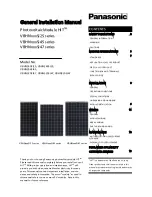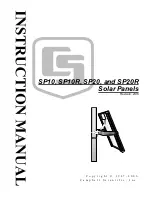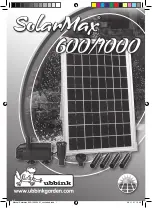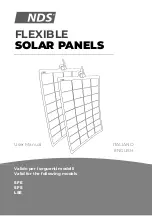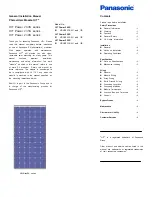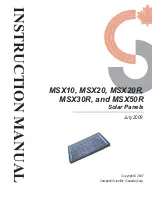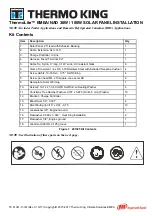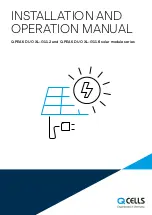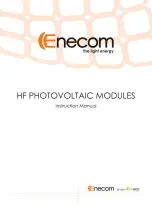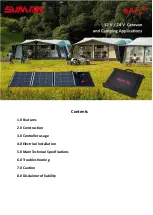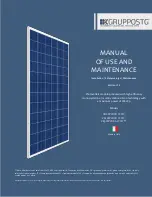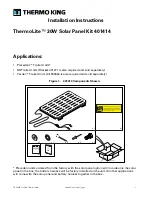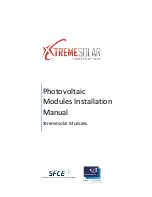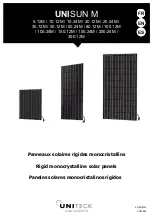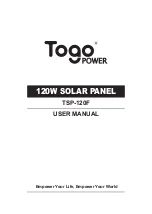
11
WIRING
GENERAL
All wiring should be done in accord-
ance with applicable electrical
codes.
All wiring should be done by a quali-
fied, licensed professional.
Wiring should be protected to help
ensure personal safety and to pre-
vent its damage.
Please connect each cable after
confirming the polarity of it is cor-
rect.
Connectors between modules must
be inserted until they click.
When connecting the connectors,
please make sure that foreign mat-
ter such as water, sand and so on do
not get inside the connector. Also,
please keep in mind that if you
leave the connector in a non-
connected state for a long period of
time, contamination of foreign mat-
ter is likely to occur.
If an extreme load is applied to the
cable, the cables may come off the
junction box body or the connect-
ors. Please connect so that a strong
load is not applied to the cable.
When fixing the cable to the stand,
make sure the minimum bending
radius of the cable is 30 mm or
more.
Do not disconnect terminals while
modules generate electricity and
connect electrical load to avoid the
hazard of electrical shock.
Cable conduits should be used in
locations where the wiring is inac-
cessible to children or small animals.
These modules contain factory in-
stalled bypass diodes. If these mod-
ules are connected each other incor-
rectly, the bypass diodes, cables, or
junction box may be damaged.
Please contact your Panasonic Au-
thorized Representative with ques-
tions regarding other electrical con-
nections if needed.
MODULE WIRING
All modules connected in series
should be of the same model num-
ber and/or type.
The number of VBHNxxxSJ25 mod-
ules can be wired in series is recom-
mended to be seventeen (17) or
fewer. If connecting eighteen (18)
modules and more in series, check
local temperature conditions to
ensure compliance with maximum
system voltage limitations.
The number of VBHNxxxSJ45 mod-
ules can be wired in series is recom-
mended to be thirteen (13) or few-
er. If connecting fourteen (14) mod-
ules and more in series, check local
temperature conditions to ensure
compliance with maximum system
voltage limitations.
The number of VBHNxxxSJ47 mod-
ules can be wired in series is recom-
mended to be twelve (12) or fewer.
If connecting thirteen (13) modules
and more in series, check local tem-
perature conditions to ensure com-
pliance with maximum system volt-
age limitations.
Do not connect module in parallel
without using connection devices
that connect to appropriate FUSE
for each series string or each mod-
ule. For the installation of connec-
tion devices, refer to the installation
manual of connection devices.
Do not connect modules in parallel
without maximum over current
protection.
ARRAY WIRING
The term “array” is used to describe
the assembly of several modules on
a support structure with associated
wiring.
When installing a PV array, the sys-
tem design must be completed with
reference to the module electrical
specifications for proper selection of
inverters, fuses, breakers, charging
controllers, batteries and other stor-
age devices. In particular, as the
temperature characteristic of the PV
module, the voltage value rises on
the low temperature side. Consider
the lowest temperature in the area
where the system is installed and
select the equipment so that it does
not exceed the rated voltage of the
equipment.
Modules are equipped with SMK
connectors (P51-5H/R51-5) as a
terminal enclosure. Use these SMK
connectors for electrical connec-
tions.
Use copper wire which is insulated
to withstand the maximum possible
system open circuit voltage. For
applications where wire conduits
are used, follow the applicable
codes for outdoor installation of
wires in conduits. Minimum diame-
ter of wire conduit is 4 mm
2
. The
temperature rating of conductor is –
40
~
90
℃.
In order to avoid submerging cables
and connectors in the water, cables
must be fixed either to the module
frame using cable fixing holes or to
the mounting structure. Also, if the
cable is not secured, a force may be
applied to the cable from the out-
side, and the module may be dam-
aged.
Do not insert PV cable between
back side and mounting structure
rail. When snow weight is applied to
the module, load may be applied to
the cable.
Verify that all fittings are properly
installed to protect cables against
damage and prevent moisture intru-
sion.
EARTH GROUND WIRING
Completely ground all modules.
When grounding the module,
please use a hole near the ground
mark displayed on the frame. For
metal parts for grounding, consider
combination that does not cause
corrosion due to dissimilar metal
contact.
We recommend installing a light-
ning rod and SPD (Surge protection
device) to reduce damage or break-
down to the PV module caused by
lightning.
Check your local codes for require-
ments.

